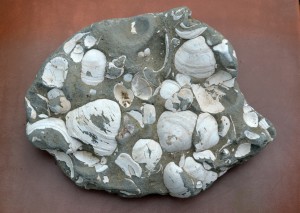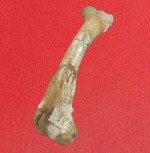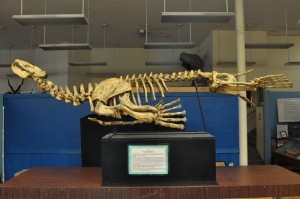Fossil Shells
|
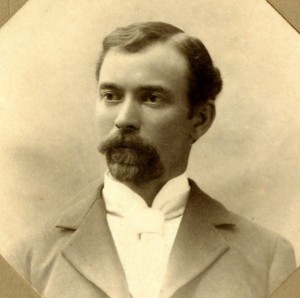 |
Frank Anderson - Much of the pioneering work on the stratigraphy of the San Joaquin Valley was done by Frank Marion Anderson (1863-1945), shown here about 1897. He used fossils to correlate the formations and other rock units he described, and he was one of the first to do this in a systematic manner. He worked for many years as a government field geologist, and later with several oil companies before going back to school to earn his Ph.D. at the age of 67 years. He went on to become the honorary curator of the UC Berkeley Museum of Paleontology. Anderson is one of the pioneering geologists of the San Joaquin Valley. |
 |
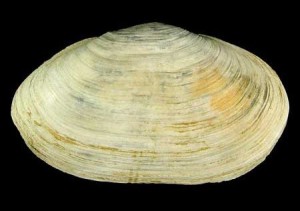
Clams - The Pliocene Etchegoin and overlying San Joaquin Formations of the San Joaquin Valley contain a very abundant and diverse fauna of marine clams. A variety of freshwater clams are also found in lacustrine sediments of the Pleistocene Tulare Formation. Clams of the species Mulinia densata. such as the example shown on the left, are abundant in the upper part of the Etchegoin, whereas species similar to the Mya japonica that is shown on the right are found in the lower part of the San Joaquin Formation. |
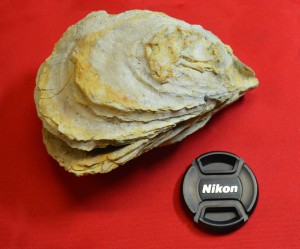 |
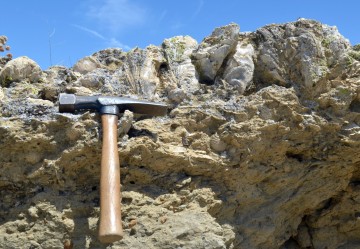
Oysters - This specimen of Ostrea titan was found in the Santa Margarita Formation (Upper Miocene) near Coalinga in the north part of the valley, not too far from the famous fossil site at Kettleman Hills. Some Ostrea oysters in growth position at the Coalinga outcrop are shown on the right. |
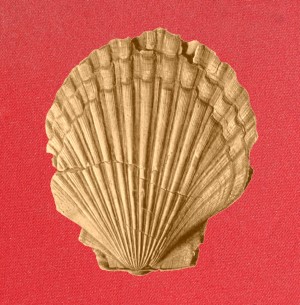 |
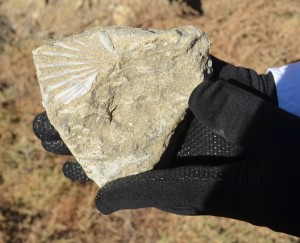
Pectens - The pecten shown here is Pecten miguelensis, and it is abundant in the Lower Miocene (Saucesian Stage) Carneros Sandstone of the Temblor Formation at the Carneros Creek type section in the Temblor Range. These are probably the largest fossil pectens found in the valley. Another well-known fossil pecten of the San Joaquin Valley is Pecten peckhami, or "PP" as it is often referred to, which is an important marker fossil that is found near the top of the Antelope Shale Member of the Miocene Monterey Formation. It has a smooth shell without the ribbing that characterizes Pecten miguelensis. |
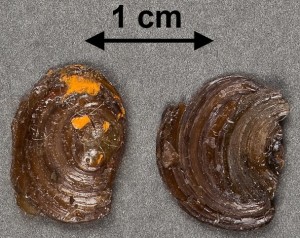 |
Limpets - Aquatic snails (Gastropods) with shells that have no coiling and are broadly conical in shape are known as "Limpets". Probably the best known fossil mollusc of this group that is found in the San Joaquin Valley is Scalez petrolia, an example of which is shown on the left. Scalez is an important marker fossil at the base of the Pliocene San Joaquin Formation. As you can from the scale bar on the photo, Scalez petrolia is quite small. |
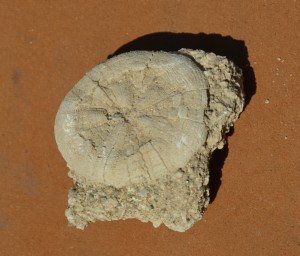 |
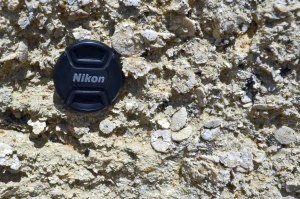
Sand Dollars - This fossil is the well-known echinoid Scutella (Astrodapsis) merriami that makes up the "buttons" of the Lower Miocene Buttonbed Sandstone of the Temblor Formation in the Temblor Range on the west side of the San Joaquin Valley. The specimens shown here are from Buttonbed Hills, which is a famous fossil collecting locality on Chico-Martinez Creek in the Temblor Range on the west side of the San Joaquin Valley. |
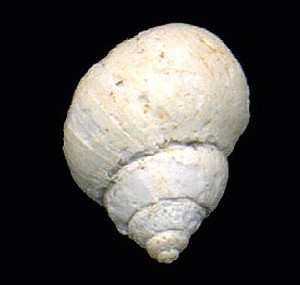 |
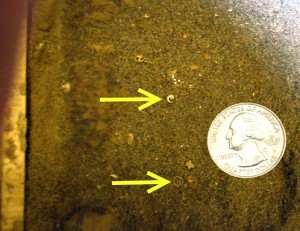
Snails - Tiny freshwater snails (Gastropods) of the Amnicola genus, only a couple of millimeters across, are abundant in some of the lake shoreface sandstones of the middle member of the Pleistocene-to-Recent Tulare Formation. An example of these snails in core on the right shows just how tiny they are. The core is from the 642G-1 well at North Belridge oil field. |
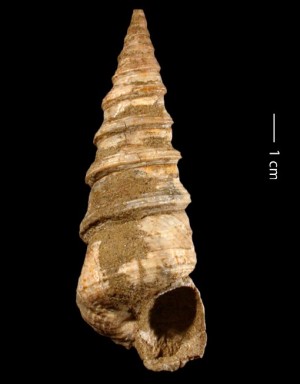 |
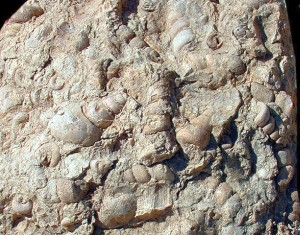
Turritellas - Aquatic snails (Gastropods) with tightly coiled shells often belong to the genus Turritellas, and they are widespread in marine, and some non-marine, rocks from the Cretaceous to the Recent. The example on the left is a Miocene Turritella ocoyana, which is abundant in the San Joaquin Valley in the Miocene Phacoides Sandstone Member of the Temblor Formation. The outcrop example that is shown on the right of a coquina that is made up almost exclusively of this same species. It is is from an outcrop in the Temblor Range, which is located on the west margin of the valley. |
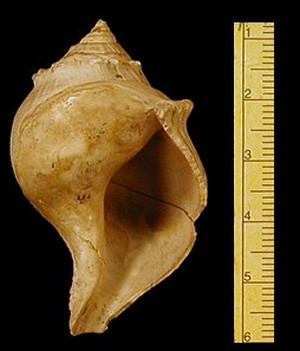 |
Whelks - Aquatic snails (Gastropods) with elongated shells that sprial down from a point to a broad middle, ans then spiral back down to a point are known as "Limpets". One of the better known fossil molluscs of this group that is found in the San Joaquin Valley is Bruclarkia barkeriana, an example of which is shown on the left. This gastropod is abundant in the Miocene Temblor Formation that is exposed in the Temblor Range on the west rim of the valley. |
Fossil Fish
of the San Joaquin Valley
There are lots fish fossils in the San Joaquin Valley including, especially in diatomites of the Miocene-age Monterey Formation. However, the best known fish fossils are the sharks teeth, which are aboundant at a collecting site called Sharktooth Hill on the east side of the valley. The teeth are found in a thin bed of sandstone in the Round Mountain Siltstone (Middle Miocene). The Buena Vista Musem of Natural History in Bakersfield has a nice display of fossil teeth from Shark Tooth Hill. A link to their website is below. There is also a nice website on Sharktooth Hill that is worth checking out also.
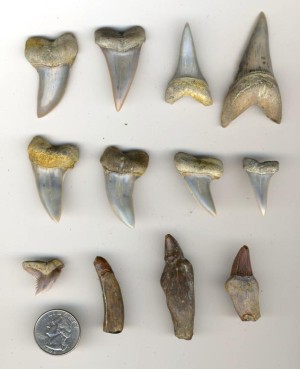
Shark Teeth from Sharktooth Hill
More fish fossils of the San Joaquin Valley
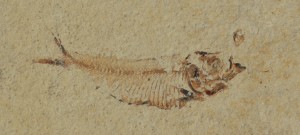 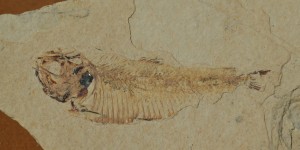 |
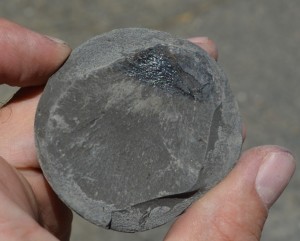
Fish imprints - These fish imprints (far left), which are only about three inches long, are typical of the fossil fish that are found in the Monterey Shale. Note the fish scale above the head of the fish in the upper photo. 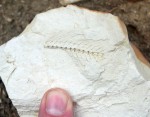 However, complete fish tend to be rare, and it is far more common to find just parts of fish, like the backbone with spines attached shown on the immediate left, which came from the Chico-Martinez creek section on the west side of the San Joaquin Valley. The imprint of either a fish fin or fish tail in a core from the lower Santos Shale is shown on the right. The core was collected in the KCL-8 well at Wasco oil field. However, complete fish tend to be rare, and it is far more common to find just parts of fish, like the backbone with spines attached shown on the immediate left, which came from the Chico-Martinez creek section on the west side of the San Joaquin Valley. The imprint of either a fish fin or fish tail in a core from the lower Santos Shale is shown on the right. The core was collected in the KCL-8 well at Wasco oil field. |
 |
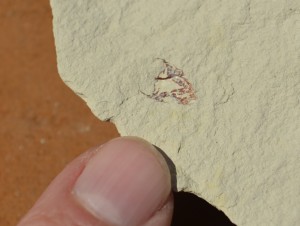
Fish scales - Fish scales are very common in many of the marine shales that crop out in the San Joaquin Valley. The left photo shows fish scale in the Santos Shale of the Temblor Formation, and the right photo shows a fish scale in the Monterey Formation. |
 |
Shark tooth - This 8-inch tooth of a Miocene-age shark at the California Living History Museum (CALM) in Bakersfield was collected from the Round Mountain Siltstone Member of the Temblor Formation at Sharktooth Hill on the east side of the valley. It is from the Large-toothed shark (Carcharocles megalodon), which probably fed on whales. |
 |
Sporbo - Reddish-brown phosphate pellets that are thought to be derived from mineralization of fish fecal pellets. The outcrop example shown on the left is from the Buttonbed Sandstone (Miocene Temblor Formation) that is exposed at Buttonbed Hill in the Temblor Range on the west side of the San Joaquin Valley. |
Fossil Mammals
of the San Joaquin Valley
A fantastic variety of ice age mammals have been collected over the years from the McKittrick tar pits on the west side of the San Joaquin Valley. We have a section on the tar pits that you can get to using the link below. We have also provided a link to the Page Museum in Brea, which is where many of the fossil bones collected from the both the McKittrick and the Brea tar pits are on display. Many fossils of marine mammals have also come from the Round Mountains Silstone Member of Temblor Formation at Shark Tooth Hill on the east side of the Valley and from the Monterey Shale on the west side.
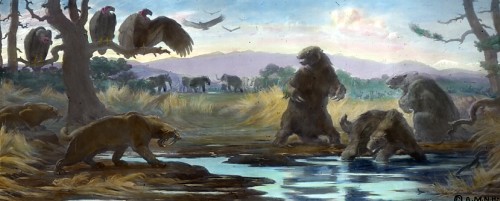
More mammal fossils of the San Joaquin Valley
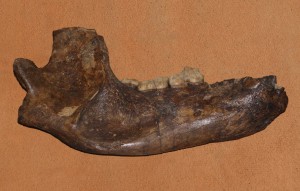 |
Bear jaw - This jaw bone from a Pleistocene short-faced bear (Arctodus simus) was found in the McKittrick tar pits and is on display at the California Museum of Living History. |
 |
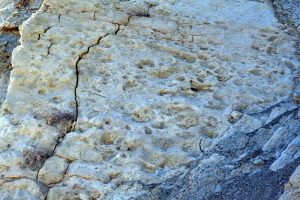
Camel bones and tracks - Bones of a Miocene camel, possibly Miolabis or a related genus, are found in the Miocene Ridge Route Formation that crops out near Pyramid Lake Dam in the California Transverse Ranges (south margin of the San Joaquin Valley).
|
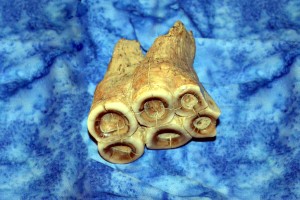 |
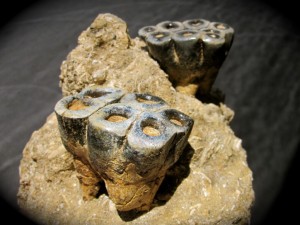
Desmostylus teeth - This creature was a funny-looking ancient marine mammal that looks sort of like a hippo. Its teeth were very hard and durable, so they tend to preserve well, which allows them to accumulate in abundance. Both of these tooth sets are from the Temblor Formation. The specimen on the left is displayed at the California Living History Museum (CALM), and was collected from Sharktooth Hill. The one on the right is an EBay listing that said it was collected near Fresno. |
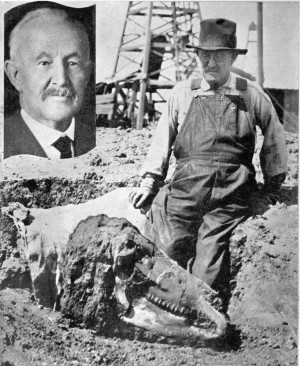 |
Horse skull - Paleontologist Charles H. Sternberg collecting a Pleistocene horse skull in 1926-27 from tar pits at McKittrick oil field. |
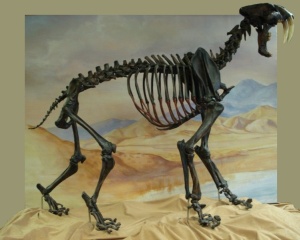 |
Saber-tooth Tiger skeleton - This Pleistocene cat on display at the West Kern Oil Museum actually came from the La Brea tar pits in Los Angeles, but similar specimens have been dug from the McKittrick tar pits as well, and are on display in other museums. |
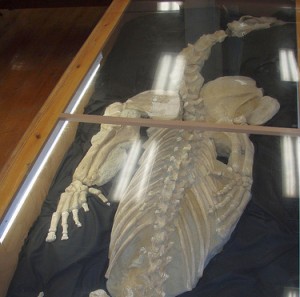 |
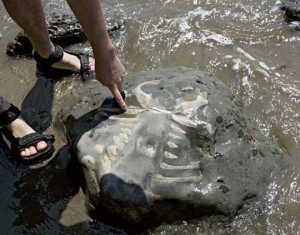 Sea Lion skeleton - Probably the best known fossil mammal to be found in the San Joaquin Valley is the fossil skeleton of an ancient sea lion of the genus Allodesmus that was found in the Miocene Round Mountain Siltstone member of the Temblor Formation at the famous Sharktooth Hill collecting locality. This fossil, which is shown below, was on display for many years at the Buena Vista Museum of Natural History in Bakersfield for all to see, until the owner of the fossil pulled it to try and auction it off to the highest bidder. Shown on the left is the current Allodesmus exhibit at the museum. Another well known sea lion fossil that was visible for many years at the base of sea cliffs of the Pliocene Purisima Formation in Capitola, California is shown on the right. The Purisima is roughly equivalent to the Etchegoin Formation of the San Joaquin Valley. We heard that the Capitola fossil was removed a few years ago by the Santa Cruz Museum of Natural History, so hopefully they have it on display these days as one of their exhibits.
Sea Lion skeleton - Probably the best known fossil mammal to be found in the San Joaquin Valley is the fossil skeleton of an ancient sea lion of the genus Allodesmus that was found in the Miocene Round Mountain Siltstone member of the Temblor Formation at the famous Sharktooth Hill collecting locality. This fossil, which is shown below, was on display for many years at the Buena Vista Museum of Natural History in Bakersfield for all to see, until the owner of the fossil pulled it to try and auction it off to the highest bidder. Shown on the left is the current Allodesmus exhibit at the museum. Another well known sea lion fossil that was visible for many years at the base of sea cliffs of the Pliocene Purisima Formation in Capitola, California is shown on the right. The Purisima is roughly equivalent to the Etchegoin Formation of the San Joaquin Valley. We heard that the Capitola fossil was removed a few years ago by the Santa Cruz Museum of Natural History, so hopefully they have it on display these days as one of their exhibits.
|
 |
Walrus skull - This specimen from the Miocene Round Mountain Siltstone member of the Temblor Formation at Sharktooth Hill is the shull of an ancient walrus of the genus Neotherium. Sharktooth hill is known not only for the wide variety of sharks teeth that are there but also for a variety of marine mamals as well. |

|
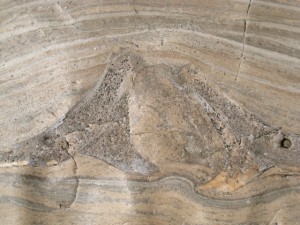
Whale bone - These two pictures of fossil whale bone in the Monterey Formation are beach rocks on the coast, but similar whale bones are found from time to time in rocks of the Monterey that crop out in the valley as well. Both of these photos were taken by Rick Behl of the University of California at Long Beach. |
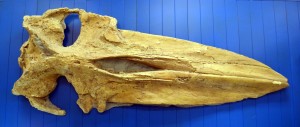 |
Whale skull - This specimen at the Buena Vista Museum of Natural History in Bakersfield was collected from the Miocene Round Mountain Siltstone member of the Temblor Formation at Sharktooth Hill on the east side of the valley. |
Fossil Dinosaurs
of the San Joaquin Valley
Believe it or not dinosaur fossils have been found in California, mainly in the Upper Cretaceous Chico and Moreno Formations in the northern San Joaquin Valley, particularly in the hills around the San Luis reservoir. However, there have also been a couple of finds in Jurassic-age Franciscan sedimentary rocks near the coast.
The fossils found include flying reptiles (pterosaurs), and a variety of marine reptiles, including turtles, mosasaurs, plesiosaurs and ichthyosaurs. There is even the recorded San Joaquin Valley find at Del Puerto Creek near Patterson in 1936 of the vertebrae and hindquarters of a hadrosaur. This land-dwelling dinosaur apparently died near the coast, which in those days was east of the modern-day Sierras, and was subsequently washed out to sea by a river. We suggest that you check a great book by Richard Hilton called Dinosaurs of California to learn more.
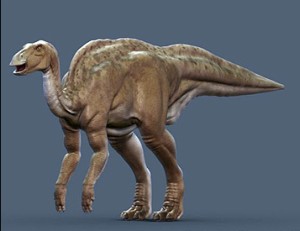
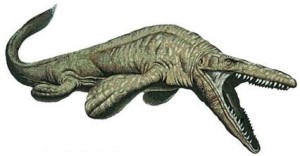
 |
Mosasaur teeth - These teeth of a marine predatory dinosaur called a mosasaur came from a BLM site in the Cretaceous Moreno Formation in the Panoche Hills west of Chowchilla. |
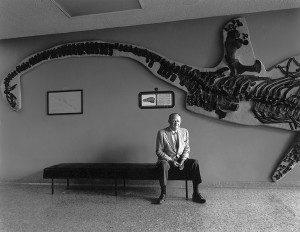 |
Plesiosaur - This plesiosaur is a Hydrotherosaurus alexandrae that was discovered in 1937 in the Cretaceous Moreno Formation in the Panoche Hills west of Fresno. It is displayed at the California Museum of Paleontology (University of California at Berkeley). A cast of this specimen is also displayed at the California Academy of Sciences.
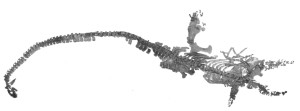 |
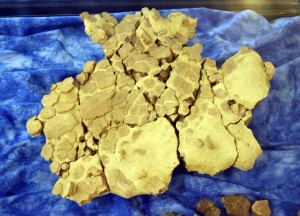 |
Turtle Shell - This interesting fossil at the California Living History Museum in Bakersfield (CALM) is the shell of a Leatherback turtle (Psephophorus californiensis) found in the Round Mountain Siltstone Member of the Temblor Formation at Sharktooth Hill on the east side of the San Joaquin Valley. |

